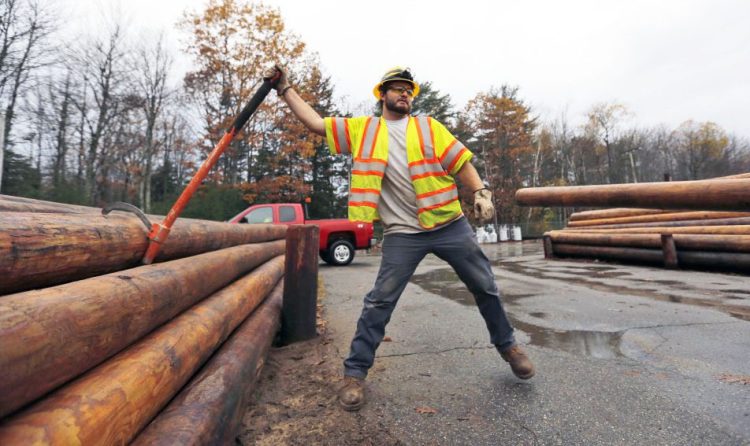Ubiquitous wood utility poles are the backbone of Maine’s electricity distribution network but typically go unnoticed day to day. Until, that is, a storm or errant vehicle brings one crashing down, taking power with it.
Central Maine Power Co. has replaced 1,416 utility poles broken in a wind storm that tore through Maine and cut off power to almost half a million customers more than a week ago. CMP expected to restore power to all but 2,000 customers by Monday night, and get the rest back up by Tuesday night.
The 2017 storm marked the largest number of broken poles for CMP since 1998, when the company replaced about 2,600 after a historic ice storm. The 1,416 number is only 0.2 percent of the 650,000 utility poles in CMP’s service network, said spokeswoman Gail Rice.
But even the relatively small percentage of poles downed can have an outsized impact on getting the lights back on. Some poles are hard to access and in some places, a special machine is needed to drill into rock ledge before a pole can be replaced, delaying power restoration.

Scott Hall, a worker for Auburn-based Power & Construction Group, unloads utility poles at CMP’s stockyard in Brunswick on Monday.
“It can take anything from one to two hours to much longer than that to replace a pole,” she said. “(Power) does take longer to restore if you have broken poles because of the time it takes to replace them.”
She also said CMP never came close to running out of poles, contrary to rumors that low stockpiles were delaying power restoration.
“We have plenty of poles, the allegations we don’t have poles are unfounded,” Rice said.
The utility is experimenting with installing thicker, more durable wood poles in storm-prone areas of the state, she said, and is testing composite poles on its transmission corridors.
U.S. electric utilities rely on simple wooden poles to carry power to customers, a distribution model that hasn’t changed substantially in more than a century, said Butch Bernhardt, a senior program manager with the North American Wood Pole Council, a trade group representing manufacturers in the Pacific Northwest and southeastern states and Canada. Douglas fir, southern pine and western red cedar poles are the most common, Bernhardt said. Some cities have buried power lines and some companies occasionally use steel or composite poles.
TIME-TESTED TECHNOLOGY
“It is a proven system that has worked, there has really been no need to make significant improvements,” he said.
Cut poles are treated with pressure and chemical preservatives to prevent decay and damage, the same basic process used since the early 20th century.
“There hasn’t been a lot in terms of new ways to do this,” Bernhardt said. “Part of the reason this way still works is the service life of wood poles.”

CMP workers move utility poles and transformers in Brunswick. The utility is experimenting with installing thicker, more durable wood poles in areas of the state most prone to storm damage, and is testing composite poles on its transmission corridors.
There are about 150 million wood utility poles in use in North America and poles can last from 35 to 70 years. In places like Arizona, where there is less threat from decay, wooden poles can last up to 90 years, Bernhardt said.
Single poles can cost $2,500 to $5,000 and even up to $10,000, Bernhardt said. Most of the poles used in the Northeast come from Southern states, he said, and it’s a responsive industry that can ramp up quickly to deal with disasters. In the four weeks after Hurricane Katrina in August 2005, utility pole companies churned out 92,000 poles and 90,000 cross arms to meet demand, and about 65,000 poles and 103,000 cross arms were made in response to superstorm Sandy in 2012, Bernhardt said.
“All utilities have a bit of supply, they typically don’t build up a supply in anticipation of storms because you don’t know what the impact is going to be,” he said.
Peter McGuire can be reached at 791-6325 or at:
pmcguire@pressherald.com
Twitter: PeteL_McGuire
Send questions/comments to the editors.



